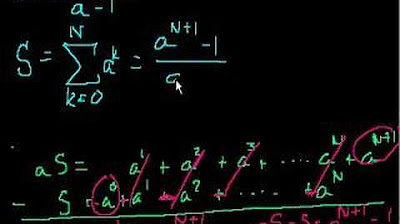TAGALOG: Geometric Series #TeacherA #GurongPinoysaAmerika
Summary
TLDRIn this educational video, Teacher A introduces the concept of a geometric series, explaining the formula for calculating the sum of the first 'n' terms, S_n = a_1 * (r^(n-1)) / (r-1). The video demonstrates how to find the sum of the first eight terms of a sequence with a common ratio of 3, resulting in a sum of 3280. Teacher A also guides viewers through finding the sum of the first five terms of another sequence with a common ratio of 4, ending with a sum of 682. The tutorial is designed to be accessible and engaging, encouraging viewers to follow along and apply the concepts.
Takeaways
- 📚 The lesson focuses on geometric series, specifically finding the sum of the first n terms.
- ✏️ The formula for the sum of the first n terms of a geometric series is: S(n) = a₁ * (rⁿ - 1) / (r - 1), where a₁ is the first term and r is the common ratio.
- 📝 In the example sequence 1, 3, 9, 27, the first term (a₁) is 1, and the common ratio (r) is 3.
- 🔢 To find the sum of the first eight terms in this sequence, substitute a₁ = 1, r = 3, and n = 8 into the formula.
- 💡 The common ratio can be found by dividing consecutive terms in the sequence (e.g., 27 ÷ 9 = 3, 9 ÷ 3 = 3).
- 🧮 In the example, 3 raised to the 8th power is 6,561, and using the formula yields a sum of 3,280 for the first eight terms.
- ➗ The second example uses the sequence 2, 8, 32, where the first term is 2 and the common ratio is 4.
- 🔍 To find the sum of the first five terms of this sequence, substitute a₁ = 2, r = 4, and n = 5 into the formula.
- 🧠 For the second sequence, 4 raised to the 5th power is 1,024, and using the formula yields a sum of 682 for the first five terms.
- 📢 The teacher invites viewers to subscribe to their YouTube channel and follow their social media for more tutorials and updates.
Q & A
What is the formula for finding the sum of the first n terms in a geometric series?
-The formula for the sum of the first n terms (Sₙ) in a geometric series is Sₙ = a₁ * (rⁿ - 1) / (r - 1), where a₁ is the first term, r is the common ratio, and n is the number of terms.
In the given sequence (1, 3, 9, 27), what is the first term (a₁)?
-The first term (a₁) in the sequence is 1.
How is the common ratio (r) calculated in a geometric series?
-The common ratio (r) is calculated by dividing one term by the previous term. For example, in the sequence (1, 3, 9, 27), 3/1 = 3, 9/3 = 3, and 27/9 = 3. So, the common ratio is 3.
What are the steps to find the sum of the first eight terms in the sequence (1, 3, 9, 27)?
-1. Identify the first term (a₁ = 1) and the common ratio (r = 3). 2. Apply the formula Sₙ = a₁ * (rⁿ - 1) / (r - 1). 3. Plug in the values: S₈ = 1 * (3⁸ - 1) / (3 - 1). 4. Calculate 3⁸ = 6561, then S₈ = 1 * (6561 - 1) / 2 = 3280.
What is the sum of the first eight terms in the sequence (1, 3, 9, 27)?
-The sum of the first eight terms is 3280.
How is the common ratio determined in the sequence (2, 8, 32)?
-The common ratio (r) is determined by dividing successive terms. In the sequence, 8/2 = 4 and 32/8 = 4, so the common ratio is 4.
What is the sum of the first five terms in the sequence (2, 8, 32)?
-The sum of the first five terms is calculated using the formula S₅ = a₁ * (r⁵ - 1) / (r - 1). Plugging in the values: S₅ = 2 * (4⁵ - 1) / (4 - 1) = 2 * (1024 - 1) / 3 = 682.
What is the value of 4 raised to the power of 5 in the second example?
-4⁵ = 1024.
What is the significance of subtracting 1 in the geometric series formula?
-Subtracting 1 from rⁿ accounts for the fact that the formula finds the sum of terms from the first to the nth term, excluding higher terms beyond n.
What is the common ratio in the second example, and how does it affect the sum of the terms?
-The common ratio in the second example is 4. A larger common ratio leads to exponentially larger terms, which significantly increases the sum as the number of terms increases.
Outlines

This section is available to paid users only. Please upgrade to access this part.
Upgrade NowMindmap

This section is available to paid users only. Please upgrade to access this part.
Upgrade NowKeywords

This section is available to paid users only. Please upgrade to access this part.
Upgrade NowHighlights

This section is available to paid users only. Please upgrade to access this part.
Upgrade NowTranscripts

This section is available to paid users only. Please upgrade to access this part.
Upgrade NowBrowse More Related Video

Barisan dan deret Geometri kelas 10

How to Find the Geometric Means? Geometric Sequence - Grade 10 Math

Menemukan rumus jumlah Deret Geometri

Grade 10 Math Q1 Ep7: Finding the nTH term of a Geometric Sequence and Geometric Means

Sequences and series (part 2)

Barisan dan Deret Bagian 4 - Deret Geometri Matematika Wajib Kelas 11
5.0 / 5 (0 votes)